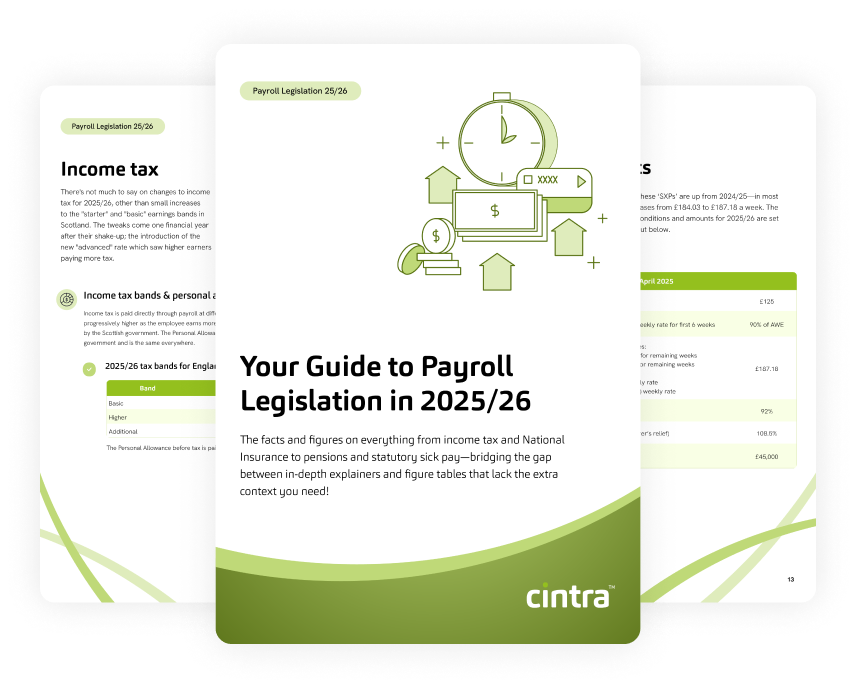As promised in this year’s Autumn Budget, there have been no increases in tax and National Insurance (NI) for employees.
Unfortunately, the same can’t be said for employers, with huge National Insurance changes afoot in April 2025.
It’s a big shake-up for all employers, with many now working behind the scenes to fully understand the financial impact that the threshold and rate changes to National Insurance will have—and how that plays out in their budget for the next financial year.
So we’ve mapped out the key national insurance changes coming in April, and what they mean for your payroll costs.
National Insurance changes
Employer’s NI to be increased from 13.8% to 15%
From April 2025, the new Employer’s National Insurance rate will go up from 13.8% to 15%, meaning payroll costs will rise for all businesses.
Employer’s NI Secondary Threshold decreasing from £9,100 to £5,000
Also from April, the Employer’s NI Secondary Threshold will drop from £9,100 to £5,000, meaning employers will start paying NI on employee earnings above £417 per month instead of £758.
The National Insurance changes in practice
It will be a noticeable impact for everyone, whether small businesses looking to find funds or large employers seeing their NI bill drastically increase.
But there’s still time to prepare, and to do that you need to get to grips with what the new national insurance rates will look like in practice in your budget.
What that looks like in practice is, of course, totally dependent on a lot of things; how many people you employ, your remuneration structures, your eligibility for the Employment Allowance, to name a few.
What we can help with, though, is a few examples of what that will look like on an employee-by-employee basis for businesses not eligible for Employment Allowance. The below table shows how much more NI you’ll pay for an employee on £20,000, an employee on £40,000, and an employee on £60,000 each month, in line with the new National Insurance changes:
| Salary | Tax Year | Monthly NI-able Earnings | Monthly Employer NI | Monthly Increase |
|---|---|---|---|---|
| £20,000 | 2024/25 | £908.67 | £125.40 | +£62.05 |
| 2025/26 | £1249.67 | £187.45 | ||
| £40,000 | 2024/25 | £2575.33 | £355.40 | +£82.05 |
| 2025/26 | £2916.33 | £437.45 | ||
| £60,000 | 2024/25 | £4242.00 | £585.40 | +£102.05 |
| 2025/26 | £4583.00 | £687.45 | ||
And an annual view per employee:
| Salary | Tax Year | Annual NI-able Earnings | Annual Employer NI | Annual Increase |
|---|---|---|---|---|
| £20,000 | 2024/25 | £10,904 | £1,504.75 | +£744.65 |
| 2025/26 | £14,996 | £2,249.4 | ||
| £40,000 | 2024/25 | £30,904 | £4,264.75 | +£984.65 |
| 2025/26 | £34,995 | £5,249.4 | ||
| £60,000 | 2024/25 | £50,904 | £7,024.75 | +£1,224.65 |
| 2025/26 | £54,996 | £8,249.4 | ||
Get the latest insights and best practice guides, direct to your inbox.
Additional National Insurance changes
Employment Allowance increasing to £10,500 and removal of the £100,000 threshold
The increase in Employment Allowance to £10,500, with no £100,000 threshold, means that more employers will be eligible for the scheme—doubling the benefit from the previous £5,000. It’s worth noting that, excluding the threshold removal, all the eligibility criteria are staying the same:
- Public bodies or businesses doing more than half of their work in the public sector and one-director companies where the director is the only employee liable for secondary Class 1 national insurance are not eligible.
- Employees who fall under IR35 are excluded from the employment allowance calculations
- Companies with de minimis state aid might also have restricted ability to claim the allowance.
Income tax and NI threshold freeze won’t be extended beyond 2028/29
The freeze on income tax and NI thresholds will end after 2028/29, meaning they’ll start increasing with inflation again. This will bring some ‘tax relief’ for employees and reduce the tax burden as wages rise, with less fiscal drag than we’ve seen over recent years. Another positive for employees to come out of National Insurance changes
Lower Earnings Limit (LEL) is increasing by £2 to £125
The Lower Earnings Limit (LEL) is set to increase by £2, bringing the weekly threshold to £125. This change means employees earning at least £125 per week will start building up eligibility for certain benefits, like State Pension or SSP.
Need a hand with National Insurance changes?
Regulatory compliance is at the absolute heart of everything we do, and that includes National Insurance changes. Whether it’s our internal experts keeping everyone informed, or our in-house developers making sure our software is up to date with National Insurance changes, you can always count on us.
To find out more about our payroll solutions and what we do to keep all our customers compliant, get in touch.

Payroll Legislation Guide
The facts, figures, thresholds and allowances for 2025/26 spanning tax, National Insurance, pensions, statutory payments and more.
Download now


